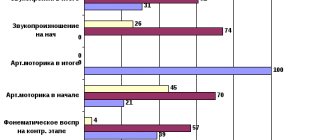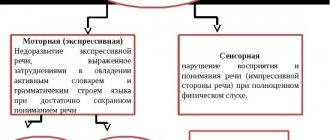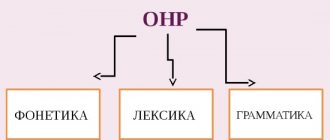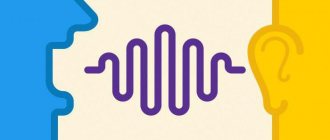Nicholas Hall Emotional Intelligence Test
The technique helps determine the level of control over your emotions and the ability to use them in everyday life. The subject is offered 30 statements; he needs to try them on himself and evaluate how true they are. There are 6 answer options to choose from: from “completely agree” to “completely disagree.”
The test evaluates EQ on 5 scales:
- Emotional awareness is the ability to correctly recognize and classify your emotions.
- Self-motivation is the ability to influence one’s behavior.
- Managing your own emotions – self-control, psychological flexibility.
- Empathy is the ability to read other people’s emotions by external manifestations, empathize with other people, and also predict their reactions.
- Managing other people's emotions is the ability to influence the emotional state of others.
More than 100 cool lessons, tests and exercises for brain development
Start developing
The reliability of the results largely depends on the degree of sincerity of the subject and the adequacy of self-perception. Therefore, I do not recommend relying only on this technique.
Go to test
Interpretation
Raw points
Statements are assigned a point value equal to the numerical value of the answer on the answer sheet. Some points are interpreted in reverse meanings:
| Possible answer | In direct terms | In reverse meanings |
| I don't agree at all | 0 points | 3 points |
| rather disagree | 1 point | 2 points |
| I rather agree | 2 points | 1 point |
| I completely agree | 3 points | 0 points |
| Scale | Direct statements | Converse statements |
| Understanding other people's emotions | 1, 3, 11, 13, 20, 27, 29, 32, 34 | 38, 42, 46 |
| Managing other people's emotions | 9, 15, 17, 24, 36 | 2, 5, 30, 40, 44 |
| Understanding your emotions | 7, 14, 26 | 8, 18, 22, 31, 35, 41, 45 |
| Managing your emotions | 4, 25, 28, 37 | 12, 33, 43 |
| Expression control | 19, 21, 23 | 6, 10, 16, 39 |
| Interpersonal emotional intelligence | 1, 3, 9, 11, 13, 15, 17, 20, 24, 27, 29, 32, 34, 36 | 2, 5, 30, 38, 40, 42, 44, 46 |
| Intrapersonal emotional intelligence | 4, 7, 14, 19, 21, 23, 25, 26, 28, 37 | 6, 8, 10, 12, 16, 18, 22, 31, 33, 35, 39, 41, 43, 45 |
| Understanding Emotions | 1, 3, 7, 11, 13, 14, 20, 26, 27, 29, 32, 34 | 8, 18, 22, 31, 35, 38, 41, 42, 45, 46 |
| Managing Emotions | 4, 9, 15, 17, 19, 21, 23, 24, 25, 28, 36, 37 | 2, 5, 6, 10, 12, 16, 30, 33, 39, 40, 43, 44 |
| General level of emotional intelligence | 1, 3, 4, 7, 9, 11, 13, 14, 15, 17, 19, 20, 21, 23, 24, 25, 26, 27, 28, 29, 32, 34, 36, 37 | 2, 5, 6, 8, 10, 12, 16, 18, 22, 30, 31, 33, 35, 38, 39, 40, 41, 42, 43, 44, 45, 46 |
Steninas
| Steninas | Raw scores on scales | |||
| MPEI | VEI | PE | UE | |
| 1 | 31 or less | 28 or less | 31 or less | 29 and less |
| 2 | 32–34 | 29–32 | 32–34 | 30–32 |
| 3 | 35–37 | 33–36 | 35–37 | 33–36 |
| 4 | 38–40 | 37–40 | 38–40 | 37–40 |
| 5 | 41–44 | 41–44 | 41–44 | 41–44 |
| 6 | 45–47 | 45–48 | 45–47 | 45–47 |
| 7 | 48–51 | 49–53 | 48–51 | 48–51 |
| 8 | 52–55 | 54–57 | 52–56 | 52–56 |
| 9 | 56 and more | 58 and more | 57 and more | 57 and more |
EQ test on the Vikium platform
This test, unlike the previous method, will not force you to delve into yourself. All you need to do is look at photographs of people and choose from a list the emotions that go with them. There are 7 of them in total: surprise, anger, joy, disgust, fear, contempt, sadness.
The technique assesses the ability to read other people's emotions. People who have it well developed are able to communicate delicately and flexibly, unlike insensitive people. The online test will show how correctly you have identified emotions and will highlight the most problematic ones.
Go to test
How developed is your child's EI?
This test is designed and adapted for parents who have children from 9 to 17 years old. It consists of 15 questions and helps assess children's behavior and feelings from the perspective of a parent. There are 3 answer options: “always”, “sometimes”, “never”. Completing the questionnaire takes no more than 15 minutes.
You will see how high your teenager’s EQ level is, how he controls his feelings, whether he consciously influences his emotions, whether he can effectively build a dialogue with others and empathize.
Take the test →
Emotional intelligence test EmIn D. V. Lyusina
The technique was developed by our domestic psychologist based on his own research. Designed for children over 13 years old and adults. It allows you to evaluate 2 indicators: interpersonal and intrapersonal intelligence. The first is responsible for the ability to navigate other people's emotions: to predict them, direct them in the right direction, empathize and even manipulate them for their own purposes.
The second indicator reflects a person’s ability to control his own emotions, that is, to restrain the manifestation of unwanted ones and evoke desired ones. These two types of intelligence are closely related, so high results on one scale are most often accompanied by high results on the other.
There are a total of 46 statements in the test with which you need to agree or disagree. And again, you will have to evaluate your abilities yourself, which leaves an imprint on the results. For example, even I, a certified psychologist, found it difficult to evaluate the statement “I easily understand the facial expressions and gestures of other people.”
Go to test
Detailed EQ test
The technique was developed by the Individual Differences Research laboratory. It is based on the research of University College London professor K. Petridis. It helps assess 15 components of emotional intelligence, including adaptability, social responsibility, self-regulation, empathy, stress tolerance, self-motivation and others.
The subject is offered 60 statements with which he must agree or refute them. After answering all tasks you will receive the result. Unfortunately, it is not as detailed as we would like. You will see how each component is developed in percentage. And the closer the indicator is to a hundred, the better things are. You will also receive an assessment of the state of the emotional sphere as a whole.
Go to test
How to improve emotional intelligence
Emotional intelligence is an important thing. He gives you an invisible shell through which barbs, sarcasm, irony and ignorance do not pass. You won't regret if you improve this skill in practice. You'll see how easier it will be to live with such a shell!
The “Emotional Intelligence” course will help you solve a lot of problems: misunderstandings with relatives, stress at work, and, in the end, you will understand why you sometimes feel so bad.
The course consists of 20 lessons. They teach:
- identify lies and “cut them in the bud”;
- see empathy and hidden emotions, change your opinion about people;
- shrewdly see all the hidden cockroaches of your interlocutor;
- identify a “rat” among friends who leaks information;
- do not show your emotions (turn on the “shell”);
- see and distance yourself from manipulation;
- establish relationships with those who would also not mind.
The cost of the course is 990 rubles.
And + bonus to advice: in addition to this small training program, on our blog you can choose one of 14 courses for EQ development.
And also if you don’t have time to study at all, from the word “AT ALL,” but you really want to raise your EI level, read the article on how to develop emotional intelligence, with effective exercises and tips.
Paul Ekman's test for identifying emotions using microexpressions
Another free method in which diagnostics are carried out using photographs. It was developed by the American scientist Paul Ekman, a specialist in the field of emotions and an expert in lie detection. By the way, Paul's daughter is a model. This is exactly what you will see in a series of 39 photographs. There are 7 emotions: anger, contempt, sadness, disgust, joy, fear, surprise. For each picture you need to choose the appropriate one.
After entering your answers, you will learn which emotions you recognize well and which ones you don’t recognize well.
Go to test
Daniel Goleman EQ Test
American psychologist Daniel Goleman has his own, different from others, view of measuring EQ. In his technique, he does not use direct questions, but asks the subject to try on one of 10 situations and try to predict his actions.
The situations are very different: a bad grade at school, unexpected shaking on a plane, a quarrel with a loved one. There are 4 behavior options to choose from in each of them. However, it remains a mystery to me how the author interprets the subject’s choice.
Go to test
Stress is an inherent human condition. Stress is not bad. What matters is how deep and how long the stress is for you specifically. And how quickly you can return to your normal, calm state. The ability to effectively cope with your stress is called stress resistance. “You shouldn't be afraid of stress. Only the dead do not have it. Stress must be managed." Hans Selye, scientist
At a low level of skill development, you experience many difficulties. If something doesn't go according to plan, you get stressed. A quarrel, a showdown is a whole test for you. You get very nervous if you are late, if something breaks, if there is little time, if something doesn’t work out. You have a hard time experiencing negative assessments addressed to you, changes in life, or the inability to control everything around you. The unknown scares you and most often you see this uncertainty in a negative light.
When you encounter obstacles, you feel like you are unable to overcome them. This causes one to give up and lose energy. And sometimes, when faced with some difficulty, it seems to you that there is a lot of energy, you are excited, you even anticipate how heroically you are coping with everything. But the time of difficulties drags on, the energy spills out, the fuse is lost, and you find yourself in a state of complete emptiness. Sleep problems begin, go away or, conversely, your appetite increases, you don’t want anything. You take a day off and sleep 17 hours, but it doesn’t help. Everything around seems gray and meaningless. You seem to be losing your bearings. You feel lost and exhausted. The negative experience is consolidated, and next time the difficulties do not excite you, but frighten you.
As you develop the skill, you will learn to effectively navigate stressful situations. Learn to manage your energy balance. You will hear your body and understand exactly when to slow down. After all, it is better to rest for 15 minutes every day than to fall out of the process for 3 months, reaching a state of burnout. You will gain self-confidence and feel the strength and belief that you are able to cope with all difficulties. Handling stress wisely is the key to health. You will understand where and how to direct your energy so as not to waste it. This will give you a feeling of concentration and focus. You will become more positive and responsible. Learn to perceive difficulties as experience, and not as difficult life trials.
Emotional intelligence test by J. Salovey and D. Caruso
This is perhaps the most reliable method to date. It allows you to assess 4 components of emotional intelligence:
- the ability to perceive and express emotions;
- the ability to use emotions to improve performance;
- the ability to understand and analyze emotions;
- the ability to manage your emotions.
There are 2 task sections for each component. Among them are such as identifying emotions from a photo, assessing the emotional coloring of the described situation, and predicting emotions. There are also very unusual and interesting tasks, for example, to describe the color and taste of a specific emotion.
The passage will take at least an hour. But you will receive a detailed and truthful description. I liked this technique more than all the others. It is interesting to take, there are no too straightforward questions, a variety of tasks and accurate results.
Go to test
EI Questionnaire by Shabanov and Aleshina
This test is suitable for children, preschool teachers and schools. There are 32 questions here, they allow you to determine which EI skills you have “at your best”, and which ones you still need to work on developing. Each statement is rated on a scale from 1 to 10. If you select a number up to 5, it means you agree with the first statement. But if from 6 to 10, you like the second statement.
Take the test →
Friends, if you want to find out much more about yourself, I advise you to take another test.
The Cognitive Abilities Test from Vikium is a diagnostic program for assessing the functioning of cognitive functions (attention, memory, thinking) and compiling a psychological profile of an individual.
What you will get as a result of the test:
- Personal profile card with assessments of cognitive abilities and personality characteristics.
- You will learn your strengths and weaknesses in various cognitive areas, as well as personality traits.
- You will understand what is associated with your productivity in certain types of activities and what needs to be done to improve it.
Testing includes complex diagnostics (cognitive profile):
- concentration and switching of attention;
- verbal and non-verbal logic;
- visual-figurative thinking;
- verbal-logical memory;
- short-term and long-term memory.
You will determine (personal profile):
- type of thinking and level of creativity;
- leading style of activity;
- ability for self-regulation;
- personality type with all its features.
Suitable for a wide range of users: teenagers over 14 years old, adults and the elderly.
You don’t need any special knowledge to pass; the test takes place in a playful and test form.
Duration: 30–40 min.
Cost: 990 rub.
Who Vikium is and why they are great, you can read in our special review.
David Ryback's method for determining the level of emotional intelligence for managers
A person holding a leadership position, like no one else, must be able to find a common language with people. And with a low EQ this is almost impossible.
The author of the book “How to Use Emotional Intelligence at Work” developed his methodology specifically for managers. If you fall into this category, be sure to take advantage of it. There are 60 questions waiting for you with answer options such as “always”, “usually”, “sometimes”, “rarely”, “never”. By answering everything, you will receive a detailed assessment of your emotional sphere and recommendations on your leadership style.
Go to test
Validation
745 subjects, 166 (22%) males and 579 (78%) females, took part in the study using the EmIn questionnaire. The age of the subjects ranged from 16 to 67 years (mean value 28.1, standard deviation 11.6). 52% of the subjects were under the age of 23 years, and therefore some types of psychometric analyzes were conducted separately by age group. The sample consisted of 25 high school students from Moscow, 374 university students from Moscow and Veliky Novgorod, studying in various specialties, and 346 specialists in various fields from Moscow and Ust-Ilimsk.
The internal consistency of the main scales ranged from 0.75 to 0.79, which is quite high for questionnaires. The internal consistency of the subscales is somewhat lower (around 0.7), but it can also be considered satisfactory, with the exception of the VE subscale (0.57).
An analysis of gender differences in the questionnaire scales was carried out. There were no significant differences between variances between men and women for any of the scales or subscales. As for the averages, men had higher values on all scales, and these differences are highly significant for the “Intrapersonal Emotional Intelligence” and “Emotion Management” scales, and are on the border of the traditionally accepted significance level of 0.05 for the “Interpersonal Emotional Intelligence” scales. and Understanding Emotions. These results are interesting because they contradict the generally accepted view (often empirically supported) that women have higher emotional intelligence. A possible explanation is that, as a self-report measure, male subjects demonstrate greater confidence in their competence and higher self-efficacy. It is noteworthy that the greatest differences are observed on those scales where the advantage of men corresponds to gender stereotypes, for example, the idea that men are better at controlling emotional expression and their own emotions in general.
The relationship between EmIn questionnaire scales and age was also analyzed. The subjects were divided into three age groups: from 16 to 25 years (431 subjects), from 26 to 45 years (221 subjects), and from 46 to 67 years (93 subjects). Analysis of variance showed that there are significant differences only on the “Intrapersonal emotional intelligence” scale – in the older age groups the average value is higher (44.7) than in the younger ones (42.6). In general, we can conclude that the age of the subjects does not significantly affect the results of the questionnaire, and therefore it is possible to carry out statistical analysis and derive test norms without taking this variable into account.
Teen EQ Analysis
The test was created for the most emotionally unstable social group. During adolescence, all events are experienced most acutely. If at this time the foundation for the formation of a healthy emotional sphere is not laid, a person may face serious psychological problems in the future.
The technique consists of 20 questions divided into 3 topics: reactions, responsibility, situations. For each question there are 4 possible answers to choose from. For each answer a certain number of points is given. At the end, you need to add up all the points and see what range the number falls into.
Go to test
How to Determine Your Emotional Intelligence Level (by Jane Stein)
This is an easy questionnaire to complete and process. It contains 22 questions. You have only 2 options for answers: “yes”, “no”. If you agree with the statement, put +1 point next to the serial number. If you don't agree, don't post anything. After completing the questionnaire, you count the points and determine their number.
You can independently assess your EQ level, since there are only 4 options for developing this skill. If the number of points is low (up to 5 points), EI must be developed; perhaps there are problems with self-esteem. If 19 or above, you are a self-control genius. The link below describes all the outcome options in more detail.
Take the test →
Test “How well do you determine a child’s feelings”
Children and adults seem to exist in two different worlds, with a gap between them. Sometimes it can be very difficult for them to come to mutual understanding. Responsibility for this naturally lies with those who are older, wiser and more experienced.
The technique helps determine how well you recognize, interpret and evaluate the child’s feelings, and how correctly you respond to them. You will be offered 5 situations from which you need to find the right way out. At the end, each situation is examined in detail and the correct answers are given. So the test performs not only a diagnostic function, but also an educational one.
Go to test
How well do you recognize a child's feelings?
This test is an excellent indicator of mutual understanding between parents and children. Its second name is “Parent Matrix”. It consists of 5 situations to which you give your answer. In the end they sort everything out and you see where and how to act.
Why is emotional education important? Parenting is based not only on love, but also on understanding the child’s feelings. It is in an understanding family that he will grow up with initially developed emotional intelligence. Try to look from the outside to see if you understand your child - take the test.
Take the test →










